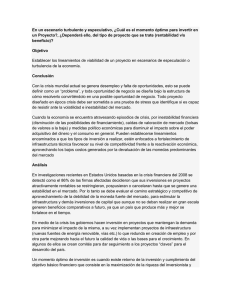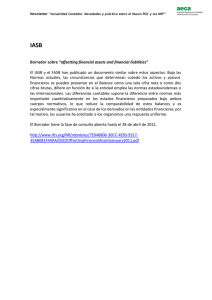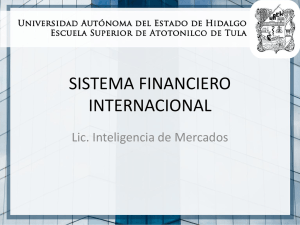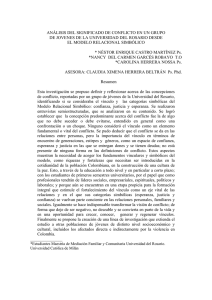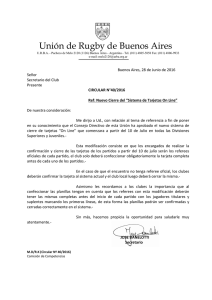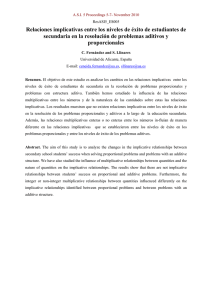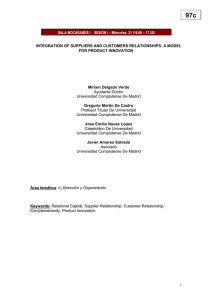El proceso de publicación de un artículo científico
Anuncio
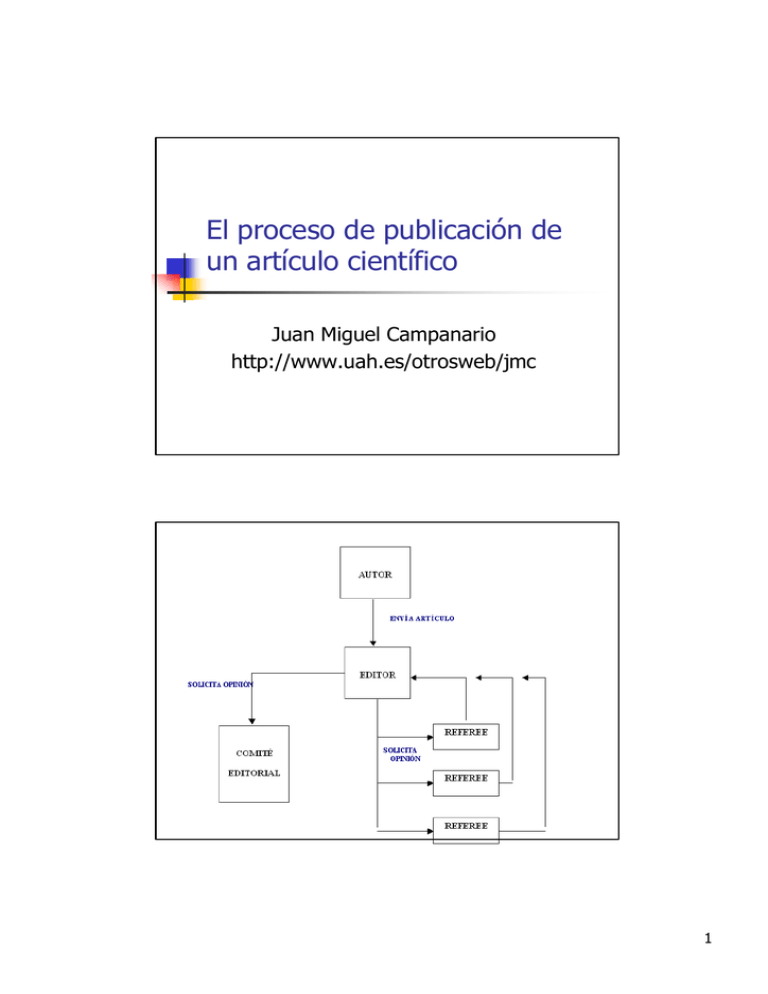
El proceso de publicación de un artículo científico Juan Miguel Campanario http://www.uah.es/otrosweb/jmc 1 Antes de elegir revista ? ? ? ? Amigos y colegas Instrucciones de las revistas Lectura en voz alta Formularios utilizados por los referees Revistas académicas ? ? ? Sistema de comunicación Colegio invisible Criterios 2 Conflicto de intereses ? ? ? De lujo a necesidad: biomedicina Problema relativamente reciente Declaración de conflicto de intereses Conflicto de intereses ? ? ? ? ? ? ? ? Patsopoulos, N.A.; Analatos, A.A.; Ioannidis, J.P.A. (2006). Origin and funding of the most frequently cited papers in medicine: database analysis. British Medical Journal, publicado on-line 17-Marzo-2006 1994 a 2003, artículos de medicina clínica más citados hasta 2004. Afiliaciones y financiación 289 artículos, 76% universidad, 57% hospital Financiación: pública (60%), industria (36%) Financiación de industria crece y se iguala a la pública en 2001 65 de las 77 pruebas clínicas más citadas tienen financiación de la industria y la proporción crece con el tiempo “Academics may be losing control of the clinical research agenda” 3 Conflicto de intereses Conflicto de intereses ? ? Authors agree to disclose all affiliations, funding sources, and financial or management relationships that could be perceived as potential sources of bias. [Science] Conflict of interest and source of funding A conflict of interests exists when an author or the author's institution has financial or personal relationships with other people or organisations that inappropriately influence (bias) his or her actions. Financial relationships are easily identifiable, but conflicts can also occur because of personal relationships, academic competition, or intellectual passion. A conflict can be actual or potential, and full disclosure to the Editor is the safest course. All submissions to The Lancet Neurology must include disclosure of all relationships that could be viewed as presenting a potential conflict of interest. The Editor may use such information as a basis for editorial decisions and will publish such disclosures if they are believed to be important to readers in judging the manuscript. At the end of the text, under a subheading Conflicts of Interest, all authors must disclose any financial and personal relationships with other people or organisations that could inappropriately influence (bias) their work. Examples of financial conflicts include employment, consultancies, stock ownership, honoraria, paid expert testimony, patent applications, and travel grants, within the past 3 years. If there are no conflicts of interest, authors should state that they have none. The corresponding author should state that he or she had full access to all the data in the study and had final responsibility for the decision to submit for publication. For any Review, Meta-analysis, Rapid Review, Personal View, or Grand Round, The Lancet Neurology will decide not to publish if an author, within the past 3 years and with a relevant company or competitor, has any stocks or shares, equity, a contract of employment, or a named position on a company board; or, in general, holds (or is applying for) a relevant patent (for the life of the patent); or has been asked by any organisation other than The Lancet Neurology to write, be named on, or to submit the paper [Lancet] 4 Revisores - referees ? ? ? ? ? ? “Guardianes de la ciencia” Número variable (13) ¿Expertos? Selecciona el editor (¿elección por autor?) No cobran Anónimos 5 Duración del proceso ? ? ? ? Depende de las áreas Sólo se puede probar con una revista Seis – siete meses (evaluación) Un año, año y medio (publicación) Resultado ? ? ? Aceptación Rechazo Revisión 6 Artículos rechazados ? ? ? ? Apelar al editor Defensor del autor Olvidar el artículo Enviar el artículo a otra revista Artículos rechazados Ray, J.; Berkwits, M.; Davidoff, F. (2000) The Fate of Manuscripts Rejected by a General Medical Journal. American Journal o Medicine, 109, 131-135. 7 Sesgos y problemas ? ? ? ? Replicación Resultados positivos Fiabilidad Validez Validez Altman, D. (2002) Poor quality medical research. What can journals do? JAMA, 287, 27652767 8 Validez ? ? ? ? ? Caso del “poliagua” Fusión fría Quinta fuerza Neutrino 17 keV “La mitad de la ciencia que enseñamos a nuestros alumnos es errónea....” Resistencia al descubrimiento ? ? ? ? ? ? Los científicos son conservadores Historia de la ciencia: casos conocidos 35 Ganadores Premio Nobel Artículos muy citados Científicos disidentes (Brian Martin) Reconocimiento tardío 9 Rechazos sonados ? ? ? Citation classics Más citados de sus revistas Importantes en el desarrollo de su disciplina Premio Nobel S. Ochoa, Acidos nucleicos H. Krebs, Ciclo de Krebs R. Yalow, Radioimmunoassays H. Michell, Fotosíntesis P.A. Cerenkov, radiación Cerenkov Kornberg, síntesis de DNA G. Binning and H. Rohrer, Microscopio túnel W.A. Fowler, Nucleogénesis 10 Científicos disidentes ? ? ? ? ? Cuestionan teorías vigentes Prestigiosos Asociaciones Revistas: Peer review (Journal of Scientific Exploration) Casos actuales: Fusión fría Científicos disidentes ? ? ? ? ? ? Halton Arp astrónomo, Monte Palomar, varios premios (Alexander von Humboldt). Big Bang Brian Josephsone Assis Premio Nobel de Física. Mente-materia. Robert G. Jahn catedrático emérito Princeton University, varios premios. Interacción mente-materia. Linus Pauling Premio Nobel de Química. Teorías alternativas sobre el cáncer. Domina Eberle Spencer catedrática University of Connecticut, varios libros, 200 artículos. Tom Van Flandern Celestial Mechanics Branch of the US Naval Observatory, premios. Big Bang. 11 Favoritismo ? ? ? Trato diferente dependiendo de la afiliación Efecto “Mateo” Endogamia Endogamia ? Lee, T. (1997) The editorial gatekeepers of the accounting academy. Accounting, Auditing and Accountability Journal, 10, 11-30 12 Endogamia ? BOE, 7 de Noviembre de 2005 Publicación redundante Mojon-Azzi, SM et. al (2003) Journals: redundant publications are bad news. Nature, 421, 209 ? ? ? ? ? ? ? 22.423 artículos, 70 revistas Publicados entre 1997-2000 Software: contrasta autores y títulos 13.967 coincidencias superiores a 0,6 Muestra aleatoria 2.210 Encuentran 60 (1.39%) redundantes ¿Punta del iceberg? 13 Publicación redundante Elm, E.V.; Poglia, G.; Walder, B.; Tramer, M.R. (2004) Different Patterns of Duplicate Publication. An Analysis of Articles Used in Systematic Reviews. JAMA, 291:974-980 Preocupación 14 Otros aspectos ? ? ? Fraudes Plagio Caso Sokal Editor: conflicto de intereses ? Endocrine Reviews, 1999 15 Alternativas ? ? ? ? ? ? Revisión doble ciega Referees no anónimos Publicar los informes de los referees Metajournal Rejected but available Más investigación 16 Rejected but available ? ? ? ? Se rechazan los artículos Se incluye una referencia (web) Autor debe estar muy seguro ¿Alumno probando con varios profesores? 17
